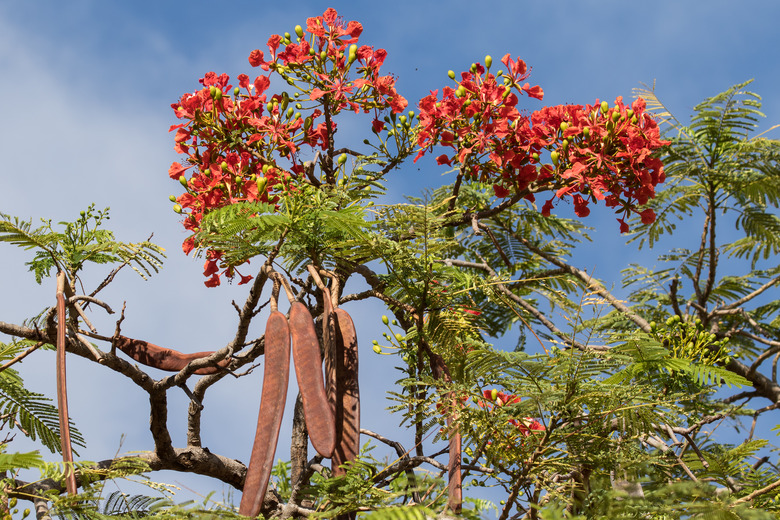Growth Rate Of The Royal Poinciana
The royal poinciana (Delonix regia) is native to Madagascar but can now be found growing in frost-free and tropical countries across the globe. They have been distributed around the world for their beautiful red flowers and bright green foliage.
These trees have naturalized in many of the countries they have been planted but are also unfortunately considered invasive in Australia, Hawaii, Cuba, the Galapagos Islands, several African countries and some of the Pacific Islands.
Read about the Baobab Tree in Madagascar.
Common Names
Common Names
Since these trees have been transplanted all over the world, they have many different common names. In French and English, they are often referred to as the flamboyant tree.
Other common English names include flame and peacock trees. Spanish has similar fire theme, calling them arbol del fuego or flor de fuego, and flamboyant colorado.
Economic Uses
Economic Uses
Poinciana are not just ornamental trees; their bark has medicinal properties that have been used for anti-diabetic, anti-inflammatory, hepatoprotective and anti-oxidant effects. The gum they produce can be used in textiles and food.
One study found that the leaf extracts of poinciana have a natural herbicidal growth reduction effect on field bindweed and wheat. This gives poinciana extracts the potential to be used as an alternative to synthetic herbicides.
Seed Germination
Seed Germination
Royal poinciana seeds are yellowish and about 0.78 inches (2 centimeters) long. The seeds are hard when they are mature. Seeds are transported via biotic vectors such as being moved by floodwaters.
The seeds may lay dormant in the soil for two, three or more years before they start to germinate; however, if conditions are right, they may take as little as 12 days to begin germinating.
Seedling Tolerances and Growth
Seedling Tolerances and Growth
Seedlings can tolerate soil pH between 4.9 to 10.6. Poinciana prefers to grow in areas with full sun, partially sunny areas may reduce their growth rate.
Once germination begins, it takes between nine and 15 days for the seedling to first emerge. Once they start to germinate, they grow quite quickly, and if being raised in nurseries, they should be transplanted at around three to five months old.
First Flowering
First Flowering
The poinciana flower is a bright red or orange color. Flowers are found in clusters on the end of branches, called an inflorescence. It takes about five years but may be as many as 12 years for first blooming to occur after they are planted. Poinciana trees can also be grown from a cutting, which reduces the time it takes for them to first start flowering.
Each flower has five petals that are 2 to 2.5 inches (5 to 6.5 centimeters) long. Four petals are the same size and scarlet-red color while the fifth petal is longer and may have a scarlet, yellow, red or white patterned coloration to attract bee and butterfly pollinators.
Read more about the types of pollination.
The entire flower reaches between 2 and 5.11 inches (5 and 13 centimeters) wide. Each delicate flower is attached with a thin 2 to 3 inch (5 to 7.6 centimeter) stalk.
Seed Pods
Seed Pods
As part of the legume family (Fabaceae), the poinciana produces long seed pods that are about 2 inches (5 centimeters) wide and 12 to 24 inches (30 to 60 centimeters) long. The seed pods are green and flexible to start with and end up being a dark brown color with a hardened case once mature.
Each pod contains 30 to 45 oblong seeds that sit next to each other horizontally down the seed pod.
Mature Poinciana Tree
Mature Poinciana Tree
A mature poinciana can reach 49 feet (15 meters) or more in height. The tree has red flowers starting in spring and lasting until early autumn. Mature trees have a thick, buttressed trunk that is about 6.6 feet (2 meters) in girth. Their canopy reaches between 40 and 60 feet (12 to 18 meters) wide.
Poinciana trees grow about 5 feet (1.5 meters) per year until they reach full height, and they can live over 50 years.
References
- CABI: Delonix Regia
- American University of Beirut: Delonix Regia
- Journal of Environmental Science, Toxicology and Food Technology: Pollinators and Its Behavior on Delonix Regia (Boj. Ex Hook) Raf. (Family: Caesalpiniaceae)
- Proceedings of the 36th Annual Conference of Horticultural Society of Nigeria (Hortson): Germination and Seedling Growth of Flame of the Forest (Delonix Regia) as Affected by Scarification Method and Dipping Duration
- World Agroforestry Center: Delonix Regia
- University of Florida: Royal Poinciana
- Brighter Blooms: Royal Poinciana
Cite This Article
MLA
Jerrett, Adrianne. "Growth Rate Of The Royal Poinciana" sciencing.com, https://www.sciencing.com/growth-rate-royal-poinciana-8496301/. 22 November 2019.
APA
Jerrett, Adrianne. (2019, November 22). Growth Rate Of The Royal Poinciana. sciencing.com. Retrieved from https://www.sciencing.com/growth-rate-royal-poinciana-8496301/
Chicago
Jerrett, Adrianne. Growth Rate Of The Royal Poinciana last modified March 24, 2022. https://www.sciencing.com/growth-rate-royal-poinciana-8496301/
